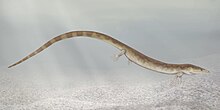| Sauropleura Temporal range: Carboniferous–Permian, | |
|---|---|
 | |
| Scientific classification | |
| Domain: | Eukaryota |
| Kingdom: | Animalia |
| Phylum: | Chordata |
| Clade: | Sarcopterygii |
| Clade: | Tetrapodomorpha |
| Order: | † Nectridea |
| Family: | † Urocordylidae |
| Subfamily: | † Sauropleurinae |
| Genus: | † Sauropleura Cope, 1868 |
Sauropleura (meaning "lizard side") is an extinct genus of nectridean tetrapodomorphs within the family Urocordylidae. Fossils are known from the United States (Texas, Ohio) and Europe (Czech Republic). The following species are included: [1]
- Sauropleura bairdi
- Sauropleura longicaudata
- Sauropleura pectinata
- Sauropleura scalaris
